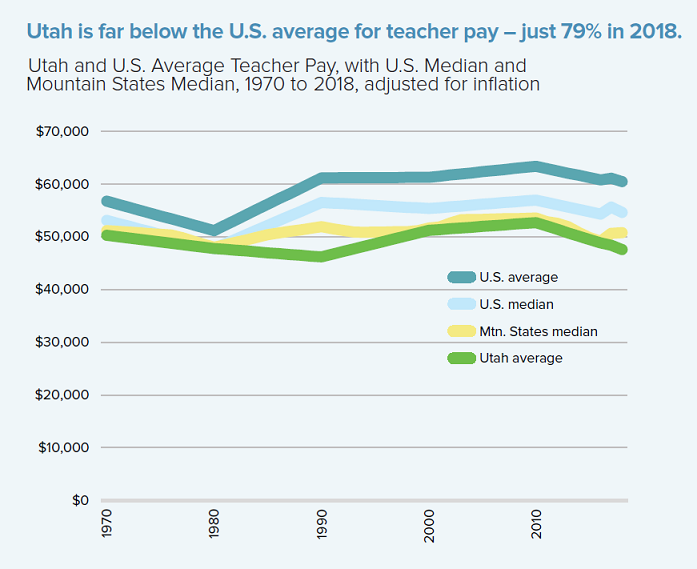IN UTAH, AS IN OTHER STATES, there is much discussion around teacher shortages. A key component of both recruiting and retaining effective teachers is to offer an appropriate level of compensation. In the report, Apples to Apples?, Utah Foundation does not indicate what the appropriate level is. It does, however, show that Utah’s average teacher pay is far lower than the national average. It is also the lowest among the Mountain States – states which struggle to staff classrooms in the face of rapid student population growth. Recruitment and retention challenges are compounded by the fact that Utah’s teachers earn significantly less than their peers the private sector with equivalent levels of education.
The report also finds that pay varies greatly between Utah’s districts. This raises the stakes in terms of competition for teachers between districts, which were particularly evident in the scramble for teacher pay increases before the beginning of the 2017-18 school year. But the report also emphasizes the importance of looking beyond average pay to take into account factors such as experience, education levels and cost of living, as well as Utah’s generous benefits package.
The question for state and district policymakers is whether the right compensation balance is in place to attract new teachers to the profession and retain highly effective teachers. And, at the end of the day, with Utah’s low per-pupil spending there are real questions about whether additional dollars will be needed to attract and retain a strong teaching force.
Key findings of the report include:
- Utah’s average teacher pay ($47,604) is significantly lower than the national average ($60,483).
- When comparing teacher pay in Utah to other Mountain States, Utah fares a bit better than it does nationally, but is still nearly 10% below the median state ($52,389). Utah’s average pay is also the lowest among the eight Mountain States. However, when factoring in experience and education levels, Utah is in the middle of the pack.
- Teacher pay varies widely among school districts within Utah, with pay for comparable levels of education and experience ranging nearly 40%.
- Utah’s teachers on average earn less than three-quarters of what private sector professionals with bachelor’s degrees in other fields earn.
- The state’s largest districts increased teacher pay by more than 10%, on average, for the 2017-18 school year – through a combination of increases to the state’s Weighted Pupil Unit program and increases in local funds, including property taxes.
- Additional increases in pay could come indirectly from the Utah Legislature or through higher local property taxes, but the level of teacher compensation is to some extent a matter of district priorities.
- A key consideration for policymakers is to consider pay in the context of total compensation, with an eye toward calibrating the compensation components to attract and retain a highly effective teaching corps.
- Nearly one out of every five education dollars is spent on teacher benefits, though a recent survey shows that most prospects for college teaching programs appear to be more interested in pay than benefits.


